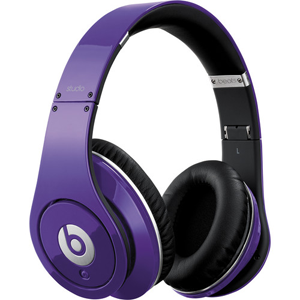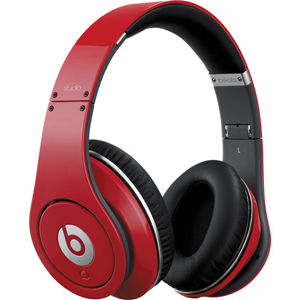 Ray Lewis, linebacker for the Baltimore Ravens, was shown walking into the stadium wearing a pair of Beats Studio headphones – from the popular line, Beats by Dr. Dre. In fact it looked very much like the entire team had these same headphones. In another shot it was very clear that Ray Rice was also wearing the same phones. And not only that, they appeared to all be purple – the Ravens team color. I’m not sure if these were made especially for the Ravens – there was nothing about this on the Beats By Dr. Dre Site.
Ray Lewis, linebacker for the Baltimore Ravens, was shown walking into the stadium wearing a pair of Beats Studio headphones – from the popular line, Beats by Dr. Dre. In fact it looked very much like the entire team had these same headphones. In another shot it was very clear that Ray Rice was also wearing the same phones. And not only that, they appeared to all be purple – the Ravens team color. I’m not sure if these were made especially for the Ravens – there was nothing about this on the Beats By Dr. Dre Site.
These seem to be the unofficial official headphones of Super Bowl XLVII. Earlier we put out a post about Colin Kaepernick walking into the stadium with a red pair Beats Studio cans. You can check out all the specs – like active noise-isolation, around-the-ear design, and smart-phone control – on that post here Headphones Colin Kaepernic Wearing At The Super Bowl – Beats Studio.
But regardless of whether they were specially-made for the Ravens or not, you can see by the picture on the left that the Beats Studio already come in purple.
If you want to get a pair of your own, CLICK HERE.
Archives for February 2013
Headphones Colin Kaepernick Wearing At The Super Bowl – Beats Studio
 Colin Kaepernick was wearing a pair of red Beats Studio headphones from the Beats By Dr. Dre line of earphones/headphones when he walked into the Super Dome on Sunday, Feb 3rd, for Super Bowl XLVII. See the picture on the left.
Colin Kaepernick was wearing a pair of red Beats Studio headphones from the Beats By Dr. Dre line of earphones/headphones when he walked into the Super Dome on Sunday, Feb 3rd, for Super Bowl XLVII. See the picture on the left.
These around-the-ear, closed back phones are perfect for noise isolation, when you just want to block out all the external noise around you. Then added to that is something called active noise-isolation technology. What that does is sort of record the frequencies of common travel noise, like plane or train engines, and then actively block it by creating a negative version of it, literally cancelling that noise out. Surely you remember your wave mechanics from physics in college, right? OK, you don’t…or you don’t care how it works, only THAT it works. When you’re quarterbacking at the Super Bowl, it’s important to be able to block out as much noise as possible so you can focus. And these headphones allow you to do just that.
Technically the name of these phones is: Beats Studio High-Definition Isolation Headphones. I mention that because even though they are awesome at blocking out noise, they also sound incredibly awesome when playing music.
And added to all that, you also get the inline mic & remote control for use with an iPhone (or other smartphones). This is compatible with the Monster ControlTalk standard. And the cables are detachable, so you can switch them out with the other of two cables that come with these cans. One is for the phone with the remote, etc. the other is just a standard cable that you can use with a portable music player or computer. Of course you could also just wear them with no cable if all you want to do is get some quiet time.
Get your own pair of Beats Studio by CLICKING HERE.
Mic Tips For Recording Live
The high energy of a live performance is irresistible to a producer. Getting the emotion and excitement of vocals to show through in a studio recording can be difficult, especially after several takes in the sometimes clinical environment of a sound booth. Getting it right the first time is the only choice with a live recording, so take your time with equipment selection and setup to avoid making extra work for yourself for after the show.
You can read the full article here: http://www.prosoundweb.com/article/capturing_the_moment_microphone_approaches_for_live_recording/
Necessary Reverb
Reverb has numerous applications for music. It can be used to contribute to the sense of space, distance, and even the size of a room. Whether you use a newer software plug-in to manage reverb or an older piece of hardware, learning more about why reverb contributes what it does to music can help you to better understand how to use it in your tracks.
You can read the full article here: http://audio.tutsplus.com/articles/general/why-reverb-is-the-most-essential-effect-in-your-toolkit/
24 Tracks Will Do The Job
Digital recording and other technology has removed many limitations from the audio industry. There is no longer any real reason that you can’t use 50 or 100+ tracks mixed together to make a song. Ignoring the daunting time requirement of mixing down 100 tracks, there is way too much room for error. Sounds get muddy, and the end product suffers.
You can read more details in the full article here: http://therecordingrevolution.com/2013/02/01/why-24-tracks-is-all-you-need/